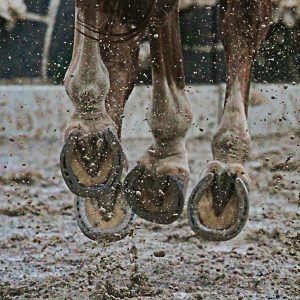What a year here in Colorado! From fetlock deep mud in the spring to humidity, summer storms and a fly plague of biblical proportion…. No wonder our horses are struggling to keep their skin intact and healthy this year!
When mammalian skin spends a prolonged period subjected to constant moisture, its natural, inherent defense mechanisms become weakened, making them susceptible to any number of dermatological conditions. For horses this year, the most common skin issue we encountered was pastern dermatitis, commonly known as “scratches”. This condition presents as an accumulation of scabs in the horse’s pastern region. It can be quite painful to palpation and even present as a source of lameness. Once the condition has been identified, the next step is softening the scabs enough so that they can be removed with as little discomfort to the horse as possible.

My tried and true remedy for scratches is a 50:50 combination of Extra Creamy Desitin (zinc oxide) and nitrofurazone. (With the mention of nitrofurazone, it is paramount to note that this is the ONLY time I ever recommend using nitrofurazone. Nitrofurazone has been shown to slow wound healing and tissue regeneration, so I never promote its use on wounds or any other skin lesions). Once you’ve mixed up a hefty amount of this magical combination product, you’ll want to slather the scabs with a thick coat of this goop and let sit for at least twelve hours. The zinc oxide is an excellent skin protectant and the nitrofurazone helps to rehydrate the scabs and hamper microbial growth.
Once the scabs have been softened, you can begin removing as many of them as possible. Keep in mind that the skin underneath is quite sore and painful so work slowly and gently to keep your horse compliant over the next few days of scab removal. Once you’ve removed as many scabs as possible that day, gently scrub the area with betadine scrub, rinse, dry and reapply the magical goop. You’ll repeat this process every 24 hours until all the scabs have been removed. At that point, it is safe to cease the betadine scrubs and just rinse, dry and reapply a light layer of the magic goop for another 5-7 days until the skin is soft and comfortable. Scratches can be prevented by keeping the legs dry and clean during the muddy season; easier said than done in many situations!
With the onslaught of flies this summer, we’ve seen many horses struggling with insect bite hypersensitivity reactions. These present as circular swollen regions and can be found all over the horse’s body and along their underbelly. In moderate to severe situations, horses may develop hives associated with this hyperactive immune response. Our initial response to a horse with insect bite associated hives is to address the excessive histamine production with an antihistamine, usually hydroxyzine, although cetirizine has also been shown to be effective in horses. If this medication is not enough to curb the immune response in the horse, steroids can also be utilized, but in select cases as some patients are at a higher risk of steroid induced laminitis with certain concurrent metabolic diseases.

Cold hosing, soothing shampoos containing oatmeal and topical over the counter steroid creams can also prove helpful. For long term management and prevention, Equishield SA has proven to be a highly effective oral supplement in our practice that promotes skin and coat health and well as supports and appropriate immune response. With the fly populations this year, the use of fly sheets, fly boots and fly masks has certainly helped to preserve the sanity of our equine patients as well! In patients who are refractory to all forms of treatment and management of allergic skin conditions, allergy testing has proven to be an effective option, although that’s a whole new topic for a separate blog!



